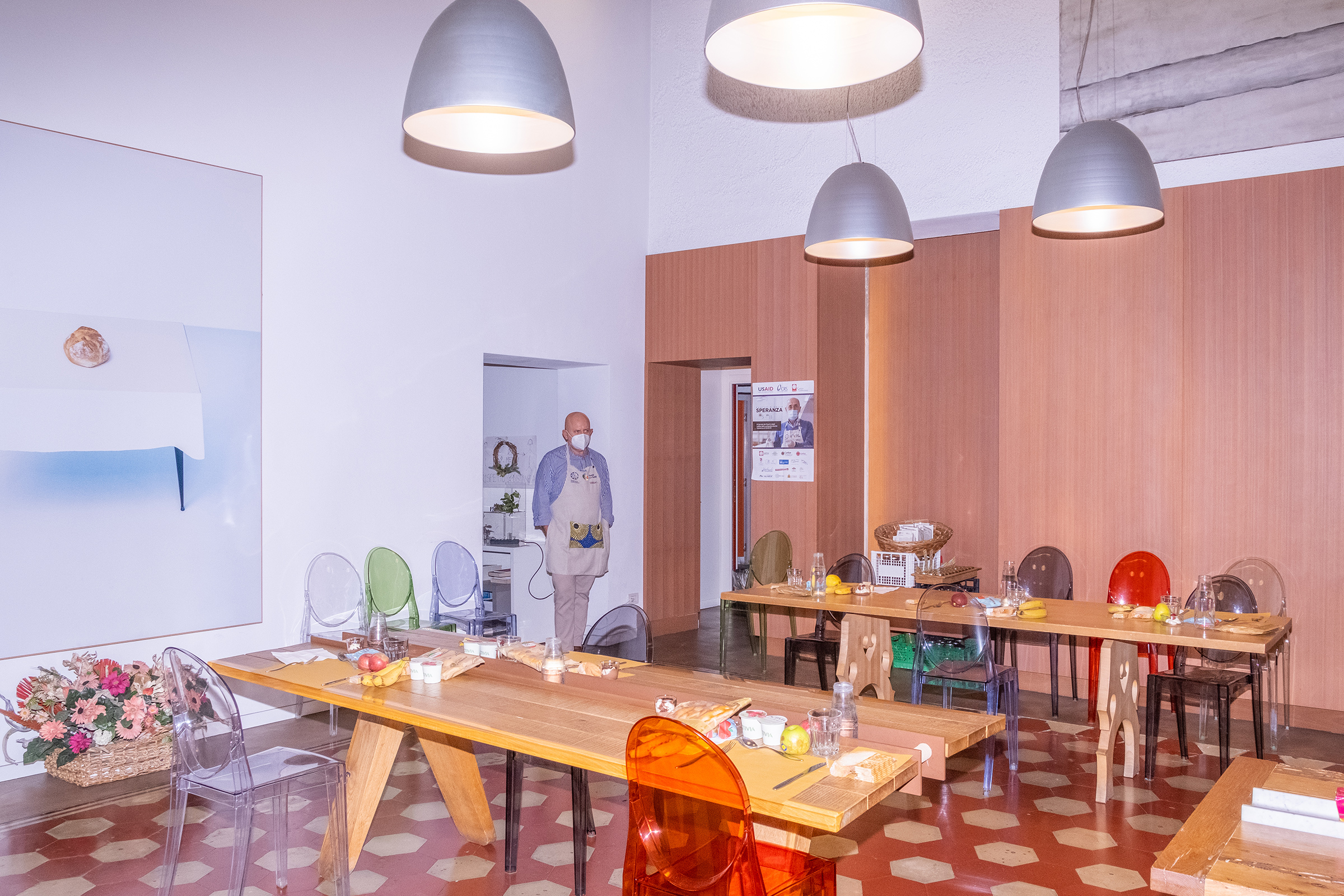Aryn Baker is the senior international climate and environment correspondent at TIME. She covers the human impacts of climate change, as well as food security, oceans, climate migration, and extreme heat.
She lives in Rome, and has reported from more than 50 countries, as TIME's Africa bureau chief based in Cape Town, the Middle East bureau chief based in Beirut, Afghanistan and Pakistan bureau chief based in Kabul and as Asia correspondent based in Hong Kong. She has won multiple awards for her writing, reporting, and documentary film work.
Chef Massimo Bottura didn’t bring his chef’s jacket to the photo shoot. Which is just as well, considering that simple chef’s whites could never convey what this exuberant bon vivant has become since opening the doors of his three-Michelin-starred, two-time winner of the best restaurant in the world, Osteria Francescana in Modena, Italy, in 1995. His culinary empire now extends from Dubai to Beverly Hills, with a new hotel in Modena that serves as an extension of his own home, with walls hung with works by Ai Weiwei, Damien Hirst and Tracey Emin. He is the author of two books and one of the stars of Netflix’s cult foodie docuseries Chef’s Table.
But out of all those successes, Italy’s most celebrated chef says the pinnacle of his achievements is Milan’s Refettorio Ambrosiano and the 12 global spin-offs that have followed in its wake.


At Refettorio Ambrosiano, dinner guests are greeted by name. They dine on fine china at tables created by the country’s most sought—after furniture designers, under works of art that would not be out of place in a contemporary art museum. The waiters are courteous, and the chefs have trained under the finest restaurateurs in the world. The set menu changes daily, depending on what comes in with the morning’s delivery.
This morning’s delivery contains wilting arugula, chicken close to its sell-by date, too-ugly-to-be-sold oranges and only enough shrimp for half the anticipated guests. But by dinner, the supermarket castoffs have been transformed into a three-course feast, the shrimp sautéed with arugula for a pasta starter and the roast chickens slathered in a fragrant orange glaze. Dessert is a rich mousse made from donated chocolate and almost-past-its-prime cream. The 100 or so diners—runaways, refugees, the homeless and the unemployed—tuck in with obvious pleasure, laughing with the volunteer waiters, praising the volunteer chefs and forgetting, at least for an hour, the challenges of a life lived on the streets of Milan.

The brightest gems in Bottura’s culinary empire are not restaurants at all. They are soup kitchens. Not that Bottura would call them that. He thinks of them as catalysts, venues that not only reaffirm the dignity of the guests, but also draw light and art into neglected neighborhoods, all while focusing attention on the growing global food-waste crisis by turning foods destined for landfill into Michelin Guide–worthy meals. “A Refettorio is not a soup kitchen,” says Bottura. “It is a cultural project that shares beauty. We treat our guests like we do at our restaurants. That’s the warm hug we are giving. We are saying ‘Welcome, this is a beautiful place, and it’s your place. This is the food that we cook for you. We are here for you.’ ”
Bottura, 59, first conceived of Refettorio Ambrosiano as a pop-up concept for the 2015 World Expo in Milan. The organizers had invited Bottura to cook for the grand opening. He demurred, proposing instead to invite the world’s best chefs to cook alongside him for the city’s homeless, using surplus food. Pope Francis, having caught wind of the idea, suggested something more permanent, and offered the use of a derelict theater belonging to a church in Greco, one of Milan’s most blighted quarters. Bottura renovated the theater in an homage to Italian art and design.


“After six years, Food for Soul is no more a project; it is a movement. It is a model for fighting food waste and social isolation on the front lines,” says Bottura from behind the wheel of his custom Maserati Levante. A gift from the Modena-based car-maker, the SUV has wheel wells and a nose splattered with the psychedelic swirls of Damien Hirst’s spin paintings, at Bottura’s request. Ever accommodating, Bottura has offered to run back home to swap his green velvet blazer for a chef’s jacket.
Driving with one hand on the steering wheel in order to leave the other free to punctuate his stream-of–consciousness musings, Bottura expounds on his theory of culture with the depth of an obsessive and the breadth of an omnivore. On his avant-garde dishes: “I have to break tradition to build new ones.” Music: “Not a crazy fan of the Beatles, but they changed the history of contemporary music.” But when asked about food waste, both hands fly off the wheel in angry exclamation points. “We are 8 billion people on earth. We produce enough food for 12 billion people. Yet 820 million people don’t have anything to eat. It’s criminal.”

Nearly a billion tons of food goes to landfill every year, and food waste is responsible for some 10% of global greenhouse-gas emissions. Project Drawdown, the climate-change nonprofit, ranks reducing food waste ahead of switching to electric cars in terms of impact.
For Bottura, fighting the crime of food waste has become second nature. At the Refettorios, chefs must make whole meals out of surplus. At his restaurants the cooks are challenged to squeeze maximum use out of every single ingredient, from meat and fish trimmings to vegetable peelings and stale bread. One of the first tasks for new chefs is to introduce themselves with a staff meal made from food that would otherwise be thrown out. Some of the items even make it to the restaurant menu, like the crackers one intern made from the rinds of Parmigiano Reggiano cheese. Even Bottura’s signature pesto is born from waste. Presented with old bread and a bunch of herbs one night, Bottura riffed on the basil-based staple by blending the mint and thyme with garlic, bread crumbs and olive oil to create a decadently creamy pasta sauce. “In Italy, if I call it pesto, they will crucify me,” he chuckles.


Turning base ingredients into gastronomic gold is Bottura’s magic. He credits his grandmother, who, like many of her wartime generation, was an adept practitioner of the Italian tradition of cucina povera, poverty cuisine. “It was the original no-waste kitchen,” he says. “What you think is food waste is just an opportunity to create something amazing.”
Most three-star chefs live in perpetual fear of losing a star. The general attitude among the 60-odd staff at Osteria Francescana and its offshoots is that the third Michelin star—earned in 2012—is not so much an accolade as a responsibility. “A third star gives you a voice,” says Lara Gilmore, Bottura’s U.S.-born wife and business partner of 25 years. “So, the question becomes, What are you going to do with it?”
Osteria Francescana is not just a restaurant anymore, but also an incubator of culinary talent with a no-waste ethos. Under Bottura’s tutelage, new chefs learn not only his particular approach to building a dish—he calls his style “emotion in a bite”—but also his commitment to making a difference in people’s lives. “In the beginning, I thought I was going to change the world,” he says. Now he realizes it’s all about getting everyone to change the world together. “Everybody has the ability to contribute to positive change. It starts with all of us, in our own kitchens.” It starts by looking at an old carrot or a stale crust of bread and catching a glimpse of gold.
More Must-Reads from TIME
- Donald Trump Is TIME's 2024 Person of the Year
- Why We Chose Trump as Person of the Year
- Is Intermittent Fasting Good or Bad for You?
- The 100 Must-Read Books of 2024
- The 20 Best Christmas TV Episodes
- Column: If Optimism Feels Ridiculous Now, Try Hope
- The Future of Climate Action Is Trade Policy
- Merle Bombardieri Is Helping People Make the Baby Decision
Contact us at letters@time.com
